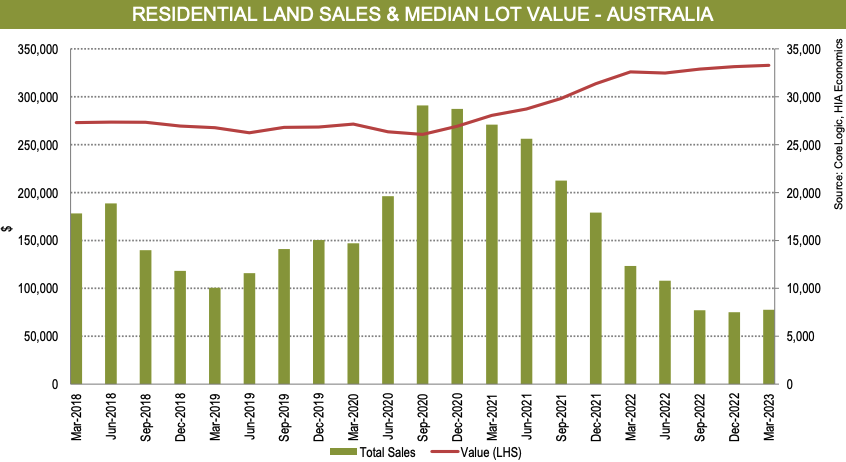Despite the ongoing housing crisis and record levels of immigration increasing demand for homes, land sales have collapsed.
The HIA-CoreLogic Residential Land Report found that the volume of residential land sales fell 37.2 per cent in the March quarter compared to last year.
Land sales are also dramatically down over the course of the decade and accounted for just half the number of lots sold in the March quarter of 2013.
At the same time, most markets across the country have seen a significant amount of price growth in the past 12 months.
According to the report, 37 of the 51 regions saw prices grow in the past year, while all capital cities recorded an increase in median lot prices over the 12-month period – the first time this has happened in nearly 10 years.

HIA Senior Economist Tom Devitt said the lack of land transactions and tight supply is likely to add more pressure to the housing crisis in the future.
“This will see the volume of new home commencements slow over the next year,” Mr Devitt said.
“This land shortage continues to drive up prices despite the sharpest increase in interest rates in over 30 years and will weigh on home building activity in the coming years.”
In the past decade, Sydney land prices have grown 133 per cent, Melbourne increased 96 per cent, while Hobart saw the highest growth at 148 per cent.
Brisbane (41 per cent), Adelaide (32 per cent) and Perth (14 per cent) also saw land prices rise in the past 10 years.

At the same time, median lot sizes have shrunk across the capital cities, with Sydney leading the decline.
Sydney lots have decreased 26 per cent, Melbourne 11 per cent, Brisbane 10 per cent, Perth 14 per cent and Hobart 13 per cent over the decade.
While Adelaide actually saw average lot sizes increase 5 per cent.

This has seen the cost per square metre surge, with all capitals experiencing higher costs per lot.
Brisbane saw the largest annual increase in its median lot price, with a 9.4 per cent increase compared to the same time last year.
Greater Adelaide’s lot prices grew by 7.4 per cent compared to the March quarter of 2022, however
they fell by 2.4 per cent compared to the December quarter.
Melbourne saw a strong annual rise in median lot prices, up 6.8 per cent on the same time in 2022.
Sydney saw the smallest rise in the past 12 months, with the median lot price in the March quarter of this year just 0.5 per cent higher than 2022.
However, Sydney remains by far the most expensive market of all capital cities with a median lot price of $664,000, up 3.8 per cent compared to the previous quarter.

Mr Devitt said as the market begins to normalise from the shocks in recent years, it is expected that both sales and prices will return to their historical trend.
“This depends on the government’s ability to adequately plan its land release pipeline, which in turn depends on the availability of data across all stages of land release,” he said.
“On average, it takes 10 years to move land through the seven stages of land release.
“Decisions made today about land release can be expected to affect housing supply 10 years from now.
“The time it takes to progress from a vacant block of land to a block that is shovel-ready with titles could be a major roadblock to the government’s plan to build a million homes over the next five years.”
CoreLogic Economist Kaytlin Ezzy said despite higher interest rates land prices overall have remained fairly resilient.
“While sales numbers have eased significantly from the peak volumes seen during the HomeBuilder scheme, it will take some time before we see a more notable recovery in supply levels,” Ms Ezzy said.
“Until then, we can expect land prices will remain elevated, dwelling approvals will continue to track below average, and house commencements will continue easing.”

